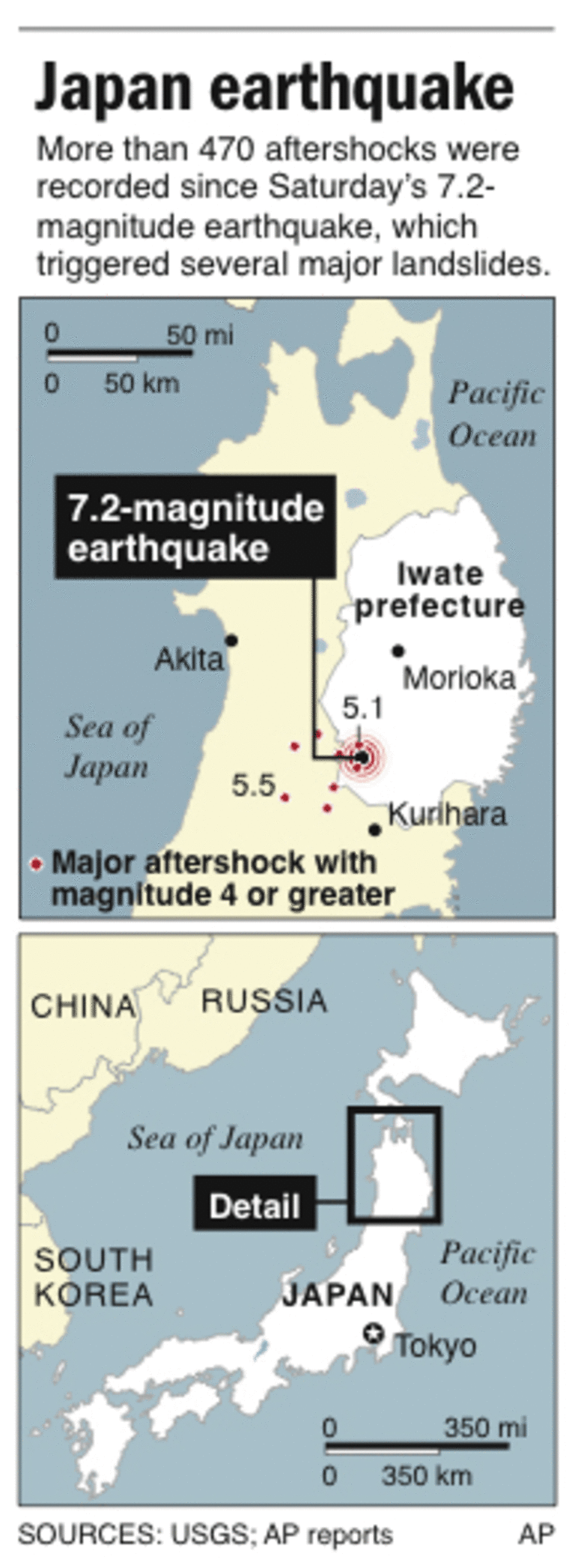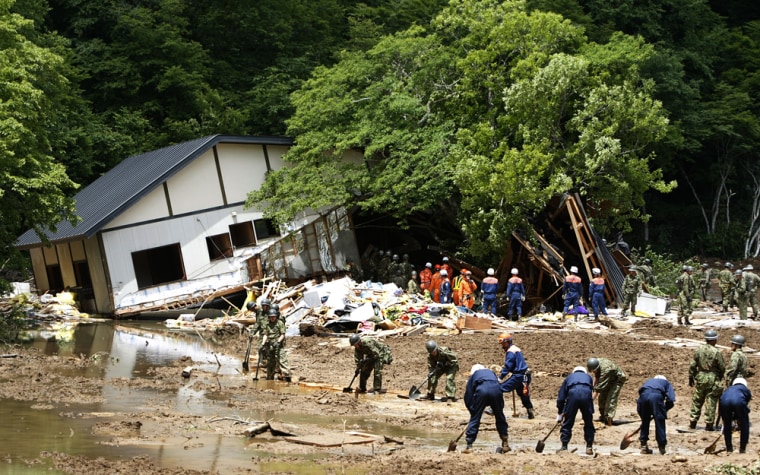Soldiers fighting through a torrent of mud and rocks dug three bodies from a hot spring resort Sunday, bringing the death toll from a magnitude 7.2-earthquake in northern Japan to at least nine, with more than 200 injured.
Rescuers, often forced to resort to shovels and buckets, raced to dig through the mire as helicopters kept watch overhead and troops on the ground used backhoes to clear roads blocked by tons of fallen rock, dirt and trees.
Three bodies of seven people believed buried by a landslide at the Komanoyu hot spring were recovered Sunday, bringing the tally of dead to nine, a National Police Agency official said on condition of anonymity, citing government policy. They died when the side of a hill came crashing down on the two-story inn where they were staying, the official said.
About a dozen people remained missing in the quake zone, a heavily forested mountainous area near the small city of Kurihara, and more than 100 people were stranded.
Powerful aftershocks
A series of powerful aftershocks has hampered the search for survivors and efforts to recover the dead. More than 470 aftershocks have been recorded since the quake hit Saturday.
A rescue effort near a dam where three construction workers were killed was called off Sunday because of fears the dam may have been cracked by the quake. The dam could break at any moment, leading to more floods and landslides, the police official said.
Many roads buckled in the quake, at least one bridge collapsed and the risk of more landslides threatened to block access to the routes that remained clear, the Fire and Disaster Agency said in a statement.
Rescue operations were arduous.
"It's so frustrating. We have hardly made any progress because of the sludge," said Masahiro Ishibashi, a soldier searching for the missing at the hot spring.
Rescue workers suspended their search for a construction worker missing after a landslide at another site in Kurihara city because of fears of more landslides and possible floods, the National Police Agency official said.
Tohoku University geologist Motoki Kazama said the area was especially vulnerable to landslides because the soil is of volcanic origin and contains a large amount of loose ash. Some of the landslides swept off the sides of the hills and spread out for several hundred yards, he said.
"With a quake of this magnitude, it isn't surprising that there was this amount of land movement," he said after finishing an inspection near the hot spring.
At a tree-planting ceremony in nearby Akita prefecture, Emperor Akihito extended his sympathy to those affected by the quake.

"I hope the missing people are rescued promptly," Akihito said. "I hope peace will return to people's lives as soon as possible."
The devastation caused by the quake was centered in a few particularly vulnerable areas, and most of the city was virtually untouched, though residents here remained fearful of the aftershocks.
Train service, water and electricity were restored to most areas. About 2,800 homes in Kurihara city were still without power, however.
'So sudden'
"It was so sudden," Yotsuko Haga, whose farmhouse was tilted and declared uninhabitable, said of Saturday's quake. "I just tried to escape to the outside, but I could barely stand."
As she spoke, another aftershock hit, prompting her and her family, who were trying to clean up the home, to run outdoors.
The 8:43 a.m. quake was centered in the northern prefecture (state) of Iwate, and was located about 5 miles underground. It was felt as far away as Tokyo, 250 miles to the southwest.
Japan is one of the most earthquake-prone areas in the world. The most recent major quake in Japan killed more than 6,400 people in the city of Kobe in January 1995.
Along with hundreds of local police and firefighters, the Defense Ministry dispatched a dozen helicopters and patrol aircraft to the region to conduct flyovers and assess the extent of damage.
The government also sent a CH-47 helicopter carrying Disaster Minister Shinya Izumi to the region.
